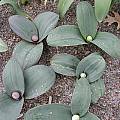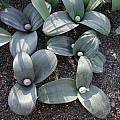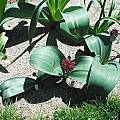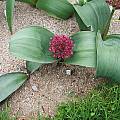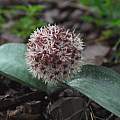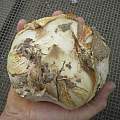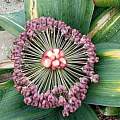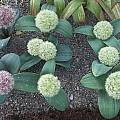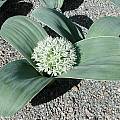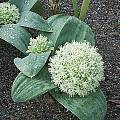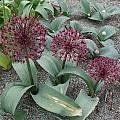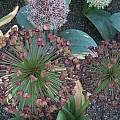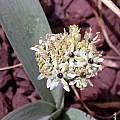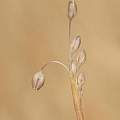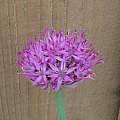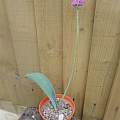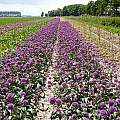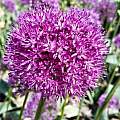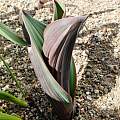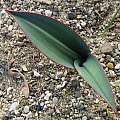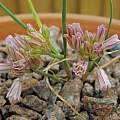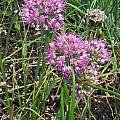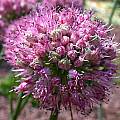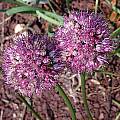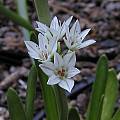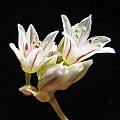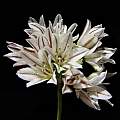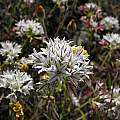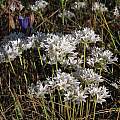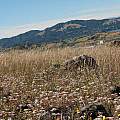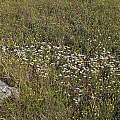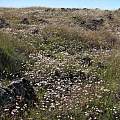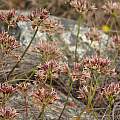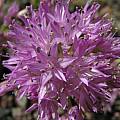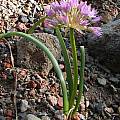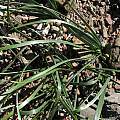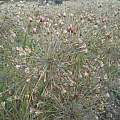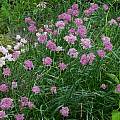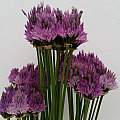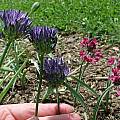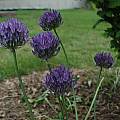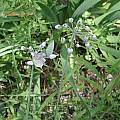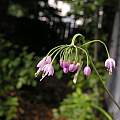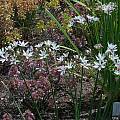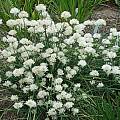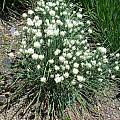This page compiles all the information and photos of the Allium taxa, cultivars, and hybrids we currently have on the PBS wiki. The Allium index gives information about the genus and includes tables of species and hybrids and cultivars.
Page 1: A. Globemaster... Page 2: A. atropurpureum... Page 3: A. carmeli... Page 4: A. decipiens... Page 5: A. guttatum... Page 7: A. membranaceum... Page 8: A. paradoxum... Page 9: A. regelii... Page 10: A. serra... Page 11: A. tardiflorum... Page 12: A. vineale...
Allium karataviense Regel is a native of Central Asia where it grows in loose limestone scree and blooms in April and May. It is a popular rock garden plant with flowers that are dried for flower arrangements. It also had beautiful broad foliage. In the first two photographs below taken by Mark McDonough we see regular A. karataviense on the left (purplish tinged foliage) and A. karataviense 'Ivory Queen' on the right (no purple tinge). The next two show 3 different forms of wild collected Allium karataviense, showing considerable diversity in foliar and flower form. The one in the center, with red flowers, is from the same locale where 'Red Globe' was first collected. All three collections are from Central Asia. The final photo by Oron Peri is of A. karataviense in its habitat.
Photos below by Wietse Mellema of a huge bulb and a plant with bulbils, respectively. It is not advisable to propagate Alliums by bulbils, it will likely result in plants that create more bulbils in place of flowers.
Allium karataviense 'Ivory Queen' is a fantastic clean white form of this popular species. It flowers the same time as the regular pinkish form, seen on the left. Photos by Mark McDonough.
Allium karataviense 'Red Globe' - This is a recently available form of A. karataviense ssp. henrikii Rukšans that's very different, flowering much earlier, with much larger and longer gray foliage, and huge globes of dark red-violet flowers. The first photo shows 3 bulbs in full bloom. The second shot shows the inflorescence swelling with red-purple seed pods and the much smaller flower globe of typical A. karataviense in the background. It's hard to believe that this hasn't been identified as a new species of subspecies of A. karataviense. Evidently, A. karataviense in the wild is extremely variable. Photos 1-2 by Mark McDonough. Third photo by Wietse Mellema.
Allium kharputense Freyn & Sint is native to Turkey and Iran where is grows on stony hillsides from 1500 to 2500 meters. It blooms late spring and has white flowers. Photo by John Lonsdale.
Allium kollmannianum Brullo, Pavone & Salmeri is from Israel. Photo by Gideon Pisanty.
Allium komarowii Lipsky (often misspelled "komarovii") is from Tajikistan and Central Asia. The first two photos provided by RH, acquired from Paul Christian. Photos three and four were taken where it was growing in a field by Wietse Mellema. The last two photos from Rimmer de Vries show the leaves.
Allium kunthianum Vved. is found in Iran, North Caucasus, Transcaucasus, and Turkey. Bulbs are ovoid with brown tunics. Stems grow from 8 to 25 cm. It has pink flowers with white petal tips, each petal with a central darker stripe on both surfaces. See a full description and a comparison to closely related Allium karsianum Fomin (a synonym of Allium paniculatum Vill.) and Allium rupestre Steven in the publication Morphological And Anatomical Investigations On Three Allium L. (liliaceae) Species Of East Anatolia, Turkey by Özdemir et al. Bangladesh J. Bot. 40(1): 9-15, 2011 (June). Photo of a dwarf form by RH (sourced from Paul Christian).
Allium kurssanovii Popov is an uncommon species, perhaps most closely related to Allium saxatile M.Bieb. This is a fairly robust plant, with narrow, densely bunching bulbs with fibrous tunics growing close to the surface and much of the bulb neck protruding above ground. The leaf bases tend to be red-striped. Flexuous, terete (round-in-cross-section) foliage and stems reach about 16" (40 cm), topped with balls of pinched bright pink flowers. Unlike most alliums that are actually sweet scented, this one is a true stinker, and all parts of the plant smell bad. If you don't like that aspect, grow Allium saxatile instead. Photos by Mark McDonough and John Lonsdale.
Allium lacunosum S.Watson is a California species that occurs widely south of San Francisco. It has small white to pale pink flowers in close umbels. There are four varieties which are distinguished by measurement of plant parts and range. The photos below are of plants in cultivation. Photo 1 taken by Mary Sue Ittner is of an unknown variety. Photos 2-3 were taken by Nhu Nguyen of variety lacunosum.
Allium lacunosum var. lacunosum has leaves that are longer than the stem (10-20 cm). The flowers measure 7-9 mm. This variety is found along the coast and in the coast ranges. The photos below were taken by Nhu Nguyen from Ring Mountain where they occur on serpentine outcrops by the thousands. The petals fade to a rusty brown and are persistent as the seeds mature.
Allium lemmonii S.Watson has a rather broad range in the western states. It is found on slopes made of mostly clay soil. It is a relative of Allium falcifolium Hook. & Arn. where the leaves are flattened and somewhat falcate. Photo 1 shows the flower head, which is rather large, and photo 2 shows the habit. Photo 3 show plants that are just starting to push up the buds. Photos by Nhu Nguyen taken at the Tilden Botanic Garden.
Allium lenkoranicum Miscz. ex Grossh is native to Azerbaijan, first discovered in 1987. It is endemic to the Talysh Mountains near the port of Lenkoran on the Caspian Sea. The leaves are thin and thread like. Photo by Wietse Mellema.
Allium lineare L. - There's much confusion over the status of the two names "strictum" and "lineare", but I'll go with the majority of thought on this one and use "lineare". A pleasant easy to grow species that makes a bright show in shades of pink in early summer (June). Seeds around a little too readily. Photo by Mark McDonough.
Allium lipskyanum Vved. is very similar to Allium cupuliferum Regel in appearance. Flowers large, narrowly cup-shaped, facing upwards, purplish. At the start of flowering the umbel is dense, later becoming lax due to the elongation of pedicels, which grow to different lengths. It originates in Central Asia. Photo by Wietse Mellema.
Allium litvinovii Drobow ex Vved. - From Central Asia, this is a rare species only recently introduced into cultivation. It's available from Pacific Rim Native Plant Nursery, and well worth the price, if it's still available. The collection data is given as Kirghizstan, Chatkal Range, near Lake Sari-Chilek. It flowers in May-June with large, intensely purple-blue balls of bloom, atop 16" (40 cm) stems. Reportedly allied to A. caesium Schrenk and A. caeruleum Pall., it is distinctive in both flower and foliage. The first photo is in early anthesis, the 2nd shot at full anthesis. Photos by Mark McDonough.
Allium macranthum Baker - First photograph is not a very good shot of this Himalayan and Chinese species, but it does show the floral detail that distinguishes the species. Very late to emerge, the flowers don't appear until late July to mid August with pendant droplets of pink to purplish flowers. The stems tend to be tall and floppy. Prefers humus rich soil in partial shade. Photos by Mark McDonough and Arnold Trachtenberg.
Allium mannii Traub & T.M.Howard - this is a Mexican species rare in cultivation. Surprisingly, many of the southwestern, Texan, and even Mexican onions are proving to be hardy in northern New England. This species is quite different than most other American onions, perhaps closed allied to A. plummerae S.Watson from Arizona and New Mexico. Allium mannii has spread slowly via short rhizomes, and reliably puts forth upfacing "rounded star-cup" flowers in open clusters for several weeks in July. As the fresh white flowers mature, the central ovaries age from pink to orangish-brown. Photo by Mark McDonough.
Allium maximowiczii Regel ssp. shibutsiense (kitam.)Ohwi 'Alba' - I obtained this from a Japanese source listed as Allium maximowiczii alba , but it's not just a white form of the much taller type species, it's the alpine form of Allium maximowiczii. The type species is found from central Asia, to China, Korea, and Japan. Allied to chives, the flowers are rather different, being shorter, more cupped-shaped, and becoming papery when going over. Dense tufts of grayish foliage, and masses of little white flowers, about 6" (15 cm) tall. Photos by Mark McDonough.
Page 1: A. Globemaster... Page 2: A. atropurpureum... Page 3: A. carmeli... Page 4: A. decipiens... Page 5: A. guttatum... Page 7: A. membranaceum... Page 8: A. paradoxum... Page 9: A. regelii... Page 10: A. serra... Page 11: A. tardiflorum... Page 12: A. vineale...
Allium index - Allium flavum Relatives - American alliums A-F - American alliums G-Z - Big Ball alliums - Blue alliums - Chives - Domed alliums - Drumstick alliums - Rhizomatous alliums
